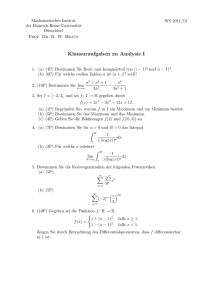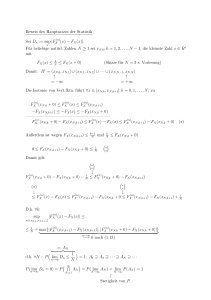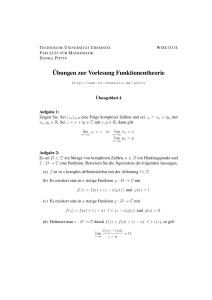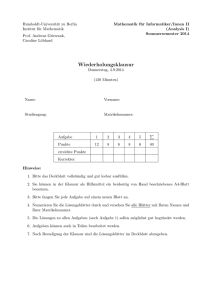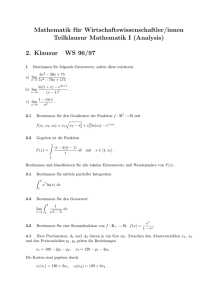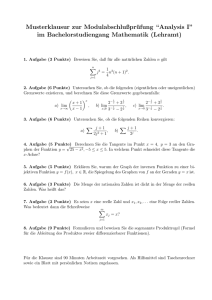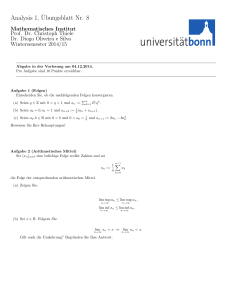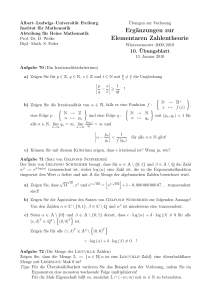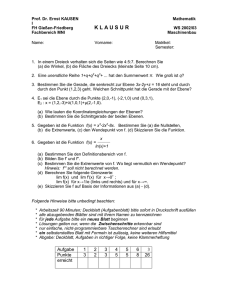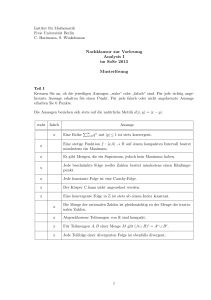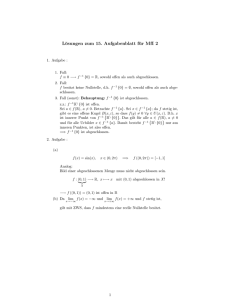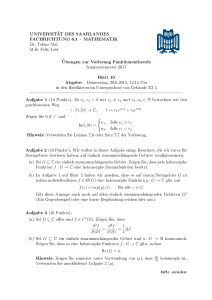Merkzettel „Analysis
Werbung
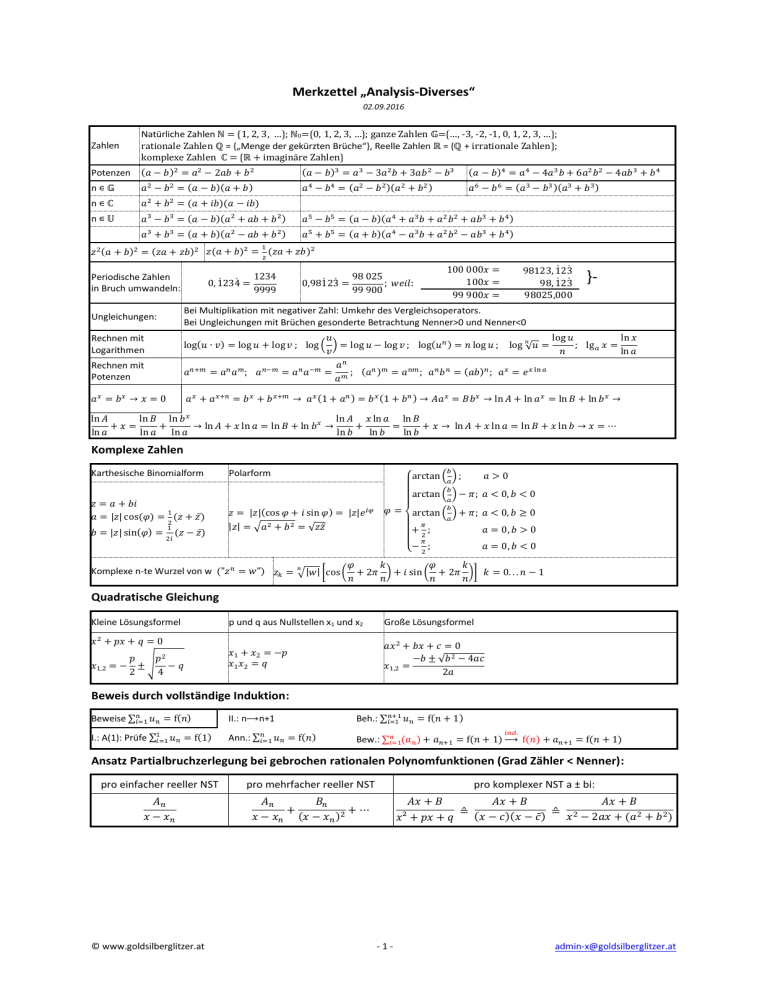
Merkzettel „Analysis-Diverses“
02.09.2016
Zahlen
Natürliche Zahlen ℕ = {1, 2, 3, …}; ℕ0={0, 1, 2, 3, …}; ganze Zahlen 𝔾={…, -3, -2, -1, 0, 1, 2, 3, …};
rationale Zahlen ℚ = {„Menge der gekürzten Brüche“}, Reelle Zahlen ℝ = {ℚ + irrationale Zahlen};
komplexe Zahlen ℂ = {ℝ + imaginäre Zahlen}
Potenzen
(𝑎 − 𝑏)2 = 𝑎2 − 2𝑎𝑏 + 𝑏2
2
(𝑎 − 𝑏)3 = 𝑎3 − 3𝑎2 𝑏 + 3𝑎𝑏2 − 𝑏3
2
4
n∊𝔾
𝑎 − 𝑏 = (𝑎 − 𝑏)(𝑎 + 𝑏)
n∊ℂ
𝑎2 + 𝑏2 = (𝑎 + 𝑖𝑏)(𝑎 − 𝑖𝑏)
n∊𝕌
𝑎3 − 𝑏3 = (𝑎 − 𝑏)(𝑎2 + 𝑎𝑏 + 𝑏2 )
3
3
4
𝑎 −𝑏 =
2
𝑎 + 𝑏 = (𝑎 + 𝑏)(𝑎 − 𝑎𝑏 + 𝑏
2)
(𝑎2
−𝑏
2 )(𝑎2
+𝑏
2)
(𝑎 − 𝑏)4 = 𝑎4 − 4𝑎3 𝑏 + 6𝑎2 𝑏2 − 4𝑎𝑏3 + 𝑏4
𝑎6 − 𝑏6 = (𝑎3 − 𝑏3 )(𝑎3 + 𝑏3 )
𝑎5 − 𝑏5 = (𝑎 − 𝑏)(𝑎4 + 𝑎3 𝑏 + 𝑎2 𝑏2 + 𝑎𝑏3 + 𝑏4 )
𝑎5 + 𝑏5 = (𝑎 + 𝑏)(𝑎4 − 𝑎3 𝑏 + 𝑎2 𝑏2 − 𝑎𝑏3 + 𝑏4 )
1
𝑧 2 (𝑎 + 𝑏)2 = (𝑧𝑎 + 𝑧𝑏)2 𝑧(𝑎 + 𝑏)2 = 𝑧 (𝑧𝑎 + 𝑧𝑏)2
Periodische Zahlen
in Bruch umwandeln:
0, 1̇234̇ =
1234
9999
0,981̇23̇ =
98123, 1̇23̇
98, 1̇23̇
98025,000
100 000𝑥 =
100𝑥 =
99 900𝑥 =
98 025
; 𝑤𝑒𝑖𝑙:
99 900
}-
Bei Multiplikation mit negativer Zahl: Umkehr des Vergleichsoperators.
Bei Ungleichungen mit Brüchen gesonderte Betrachtung Nenner>0 und Nenner<0
Ungleichungen:
Rechnen mit
Potenzen
𝑢
log 𝑢
ln 𝑥
log(𝑢 ∙ 𝑣) = log 𝑢 + log 𝑣 ; log ( ) = log 𝑢 − log 𝑣 ; log(𝑢𝑛 ) = 𝑛 log 𝑢 ; log 𝑛√𝑢 =
; lg 𝑎 𝑥 =
𝑣
𝑛
ln 𝑎
𝑎𝑛
𝑎𝑛+𝑚 = 𝑎𝑛 𝑎𝑚 ; 𝑎𝑛−𝑚 = 𝑎𝑛 𝑎−𝑚 = 𝑚 ; (𝑎𝑛 )𝑚 = 𝑎𝑛𝑚 ; 𝑎𝑛 𝑏𝑛 = (𝑎𝑏)𝑛 ; 𝑎 𝑥 = 𝑒 𝑥 ln 𝑎
𝑎
𝑎𝑥 = 𝑏𝑥 → 𝑥 = 0
𝑎 𝑥 + 𝑎 𝑥+𝑛 = 𝑏 𝑥 + 𝑏 𝑥+𝑚 → 𝑎 𝑥 (1 + 𝑎𝑛 ) = 𝑏 𝑥 (1 + 𝑏 𝑛 ) → 𝐴𝑎 𝑥 = 𝐵𝑏 𝑥 → ln 𝐴 + ln 𝑎 𝑥 = ln 𝐵 + ln 𝑏 𝑥 →
Rechnen mit
Logarithmen
ln 𝐴
ln 𝐵 ln 𝑏 𝑥
ln 𝐴 𝑥 ln 𝑎 ln 𝐵
+𝑥 =
+
→ ln 𝐴 + 𝑥 ln 𝑎 = ln 𝐵 + ln 𝑏 𝑥 →
+
=
+ 𝑥 → ln 𝐴 + 𝑥 ln 𝑎 = ln 𝐵 + 𝑥 ln 𝑏 → 𝑥 = ⋯
ln 𝑎
ln 𝑎 ln 𝑎
ln 𝑏
ln 𝑏
ln 𝑏
Komplexe Zahlen
Karthesische Binomialform
𝑧 = 𝑎 + 𝑏𝑖
1
𝑎 = |𝑧| cos(𝜑) = (𝑧 + 𝑧̅)
𝑏 = |𝑧| sin(𝜑) =
2
1
2𝑖
(𝑧 − 𝑧̅)
𝑏
Polarform
arctan ( ) ;
𝑎>0
𝑎
𝑏
arctan ( ) − 𝜋; 𝑎 < 0, 𝑏 < 0
𝑎
𝑧 = |𝑧|(cos 𝜑 + 𝑖 sin 𝜑) =
|𝑧| = √𝑎2 + 𝑏2 = √𝑧𝑧̅
|𝑧|𝑒 𝑖𝜑
𝜑 = arctan (𝑏 ) + 𝜋; 𝑎 < 0, 𝑏 ≥ 0
𝜋
𝑎
+ ;
𝑎 = 0, 𝑏 > 0
{− 2 ;
𝑎 = 0, 𝑏 < 0
2
𝜋
𝜑
𝑘
𝜑
𝑘
Komplexe n-te Wurzel von w ("𝑧 𝑛 = 𝑤") 𝑧𝑘 = 𝑛√|𝑤| [cos ( + 2𝜋 ) + 𝑖 sin ( + 2𝜋 )] 𝑘 = 0. . . 𝑛 − 1
𝑛
𝑛
𝑛
𝑛
Quadratische Gleichung
Kleine Lösungsformel
p und q aus Nullstellen x1 und x2
Große Lösungsformel
𝑥1 + 𝑥2 = −𝑝
𝑥1 𝑥2 = 𝑞
𝑎𝑥 2 + 𝑏𝑥 + 𝑐 = 0
−𝑏 ± √𝑏2 − 4𝑎𝑐
𝑥1,2 =
2𝑎
2
𝑥 + 𝑝𝑥 + 𝑞 = 0
𝑝2
𝑝
𝑥1,2 = − ± √ − 𝑞
2
4
Beweis durch vollständige Induktion:
Beweise ∑𝑛𝑖=1 𝑢𝑛 = f(𝑛)
II.: n⟶n+1
Beh.: ∑𝑛+1
𝑖=1 𝑢𝑛 = f(𝑛 + 1)
I.: A(1): Prüfe ∑1𝑖=1 𝑢𝑛 = f(1)
Ann.: ∑𝑛𝑖=1 𝑢𝑛 = f(𝑛)
Bew.: ∑𝑛𝑖=1(𝑎𝑛 ) + 𝑎𝑛+1 = f(𝑛 + 1) →
𝑖𝑛𝑑.
f(𝑛) + 𝑎𝑛+1 = f(𝑛 + 1)
Ansatz Partialbruchzerlegung bei gebrochen rationalen Polynomfunktionen (Grad Zähler < Nenner):
pro einfacher reeller NST
pro mehrfacher reeller NST
pro komplexer NST a ± bi:
𝐴𝑛
𝑥 − 𝑥𝑛
𝐴𝑛
𝐵𝑛
+
+⋯
𝑥 − 𝑥𝑛 (𝑥 − 𝑥𝑛 )2
𝐴𝑥 + 𝐵
𝐴𝑥 + 𝐵
𝐴𝑥 + 𝐵
≙
≙ 2
(𝑥 − 𝑐)(𝑥 − 𝑐̅)
𝑥 − 2𝑎𝑥 + (𝑎2 + 𝑏 2 )
𝑥² + 𝑝𝑥 + 𝑞
© www.goldsilberglitzer.at
-1-
[email protected]
Regel von de l‘Hôspital
Ausdruck
𝐟(𝒙)
𝐠(𝒙)
𝟎
∞
𝟎
∞
= „ “ oder „ “
f(𝑥)
f′(𝑥)
= lim
𝑥→𝑐 g(𝑥)
𝑥→𝑐 g′(𝑥)
lim
𝐟(𝒙) 𝐠(𝒙) = „𝟎 ∙ ∞“
lim𝑥→𝑐 f(𝑥) g(𝑥) =
lim𝑥→𝑥
f(𝑥)
1
g(𝑥)
0
=„ “
𝐟(𝒙)𝐠(𝒙) = „𝟏∞ “; „𝟎𝟎 “ oder „∞𝟎 “
lim g(𝑥) ln(f(𝑥))
lim f(𝑥)g(𝑥) = 𝑒 𝑥→𝑐
𝑥→𝑐
𝐟(𝒙) − 𝐠(𝒙) = „∞ − ∞“
lim𝑥→𝑐 (f(𝑥) − g(𝑥)) =
=
lim𝑥→𝑥
„𝑒 ∞∙0 “ oder „𝑒 0∙∞ “
0
1
1
−
g(𝑥) f(𝑥)
1
f(𝑥) g(𝑥)
0
=„ “
0
Erweitertes Horner-Schema:
P5
x0
3
x0
2
𝑃3 (𝑥) = 𝑎3 𝑥 + 𝑎2 𝑥 + 𝑎1 𝑥 + 𝑎0
x0
x0
a3
/
a3
/
a3
/
a3
/
a2
+x0a3
∑2
+x0a3
∑2
+x0a3
∑2
a1
+x0∑2
∑1
+x0∑2
∑1
a0
+x0∑1
∑0
∙ 0! = P(x0)
∙ 1! = P‘(x0)
∙ 2! = P‘‘(x0)
Analytische Geometrie
Gerade:
𝑦 = 𝑘𝑥 + 𝑑
𝑎𝑥 + 𝑏𝑦 = 𝑐
P1/k: 𝑦 − 𝑦1 = 𝑘(𝑥 − 𝑥1 )
P1/ P: 𝑦 − 𝑦1 =
Kreis
𝑥² + 𝑦² = 𝑟²
(𝑥 − 𝑥𝑚 )2 + (𝑦 − 𝑦𝑚 )2 = 𝑟 2
Spaltgleichung: 𝑥0 𝑥 + 𝑦0 𝑦 = 𝑟 2 ; oder allgemein:
(𝑥0 − 𝑥𝑚 )(𝑥 − 𝑥𝑚 ) + (𝑦0 − 𝑦𝑚 )(𝑦 − 𝑦𝑚 ) = 𝑟 2
Parabel
𝑦 = 𝑎𝑥 2
(𝑦 − 𝑦𝑠 ) = 𝑎(𝑥 − 𝑥𝑠 )2
Spaltgleichung
Ellipse
Hyperbel
𝑦2 −𝑦1
𝑥2 −𝑥1
(𝑥 − 𝑥1 )
𝜑 = arctan
𝑦0 + 𝑦
= 𝑎𝑥0 𝑥
2
𝑘2 − 𝑘1
1 + 𝑘1 𝑘2
a>0: nach oben offen
ay<0: nach unten offen
𝑥0 𝑥 𝑦0 𝑦
(𝑥 − 𝑥𝑚 )2 (𝑦 − 𝑦𝑚 )2
𝑥 2 𝑦2
+ 2=1
+
= 1 Spaltgleichung 2 + 2 = 1
2
𝑎
𝑏
𝑎
𝑏
𝑎2
𝑏2
𝑥0 𝑥 𝑦0 𝑦
(𝑥 − 𝑥𝑚 )2 (𝑦 − 𝑦𝑚 )2
𝑥 2 𝑦2
−
=1
−
= 1 Spaltgleichung 2 − 2 = 1
𝑎
𝑏
𝑎2 𝑏2
𝑎2
𝑏2
Sonstiges
𝑛!
𝑛
Binomialkoeffizient: ( ) =
𝑘
𝑘! (𝑛 − 𝑘)!
Lagrange-Polynom:
𝑛
𝑛
( )=(
)
𝑘
𝑛−𝑘
𝑛
𝑛
𝑛
𝑛
( )=( )=1 ( )=(
)=𝑛
0
𝑛
1
𝑛−1
(𝑥−𝑥𝑗 )
𝐺𝑒𝑔.: {(𝑥1 , 𝑦1 ), … , (𝑥𝑛 , 𝑦𝑛 )}; φ𝑖 (𝑥) = ∏𝑛𝑗=1;𝑗≠𝑖 (𝑥
Kontraposition: (𝐴 ⇒ 𝐵) ⇔ (¬𝐵 ⇒ ¬𝐴)
𝑖 −𝑥𝑗 )
(
𝑛
𝑛
𝑛+1
)=(
)+( )
𝑘−1
𝑘
𝑘
; p(𝑥) = ∑𝑛𝑖=1 𝑦𝑖 φ𝑖 (𝑥)
Negation: ¬(∀𝑥 ∈ 𝑀: A(𝑥)) ⇔ (∃𝑥 ∈ 𝑀: ¬A(𝑥)) ¬(∃𝑥 ∈ 𝑀: A(𝑥)) ⇔ (∀𝑥 ∈ 𝑀: ¬A(𝑥))
Injektiv: ∀𝑎1 , 𝑎2 ∈ 𝐴: 𝑎1 ≠ 𝑎2 : f(𝑎1 ) ≠ f(𝑎2 ) Surjektiv: ∀𝑏 ∈ 𝐵: ∃𝑎 ∈ 𝐴: 𝑏 = f(𝑎) bijektiv = injektiv ˄ surjektiv
Dreiecksungleichungen: |𝑥 ± 𝑦| ≤ |𝑥| + |𝑦|; |𝑥 ± 𝑦| ≥ ||𝑥| − |𝑦||; |𝑥𝑦| ≤ |𝑥||𝑦|
Komposition: 𝑔 ∘ 𝑓 = g(f(𝑎))
f(𝑥) + f(−𝑥)
f(𝑥) − f(−𝑥)
Gerade Funktion: 𝑓(𝑥) = 𝑓(−𝑥) Ungerade Funktion: 𝑓(𝑥) = −𝑓(−𝑥)
f𝐺 (𝑥) =
; f𝑈 (𝑥) =
2
2
Konvex: f((1 − 𝜆)𝑥1 + 𝜆𝑥2 ) ≤ (1 − 𝜆) f(𝑥1 ) + 𝜆 f(𝑥2 ) ; 𝜆 ∈ (0,1) Konkav: f((1 − 𝜆)𝑥1 + 𝜆𝑥2 ) ≥ (1 − 𝜆) f(𝑥1 ) + 𝜆 f(𝑥2 ) ; 𝜆 ∈ (0,1)
Stetig an c: lim𝑥→𝑐 f(𝑥) = f(𝑐) ⟺ ∀𝜀 > 0: ∃ δ(𝜀) > 0: ∀𝑥: |𝑐 − 𝑥| < δ: |f(𝑐) − f(𝑥)| < 𝜀
Hebbar unstetig: lim𝑥→𝑐− f(𝑥) = lim𝑥→𝑐+ f(𝑥)
Gleichmäßig stetig: ∀𝜀 > 0: ∃ δ(𝜀) > 0: ∀𝑥1 , 𝑥2 : |𝑥1 − 𝑥2 | < δ: |f(𝑥1 ) − f(𝑥2 )| < 𝜀
Lipschitz-stetig: ∀𝑥1 , 𝑥2 ∈ 𝐼: |f(𝑥1 ) − f(𝑥2 )| ≤ 𝐿|𝑥1 − 𝑥2 |
Lipschitz-stetig ⟹ gleichmäßig stetig: δ(𝜀) = 𝜀/𝐿
Eine auf einem kompakten Intervall stetige Funktion ist dort beschränkt.
© www.goldsilberglitzer.at
-2-
[email protected]
